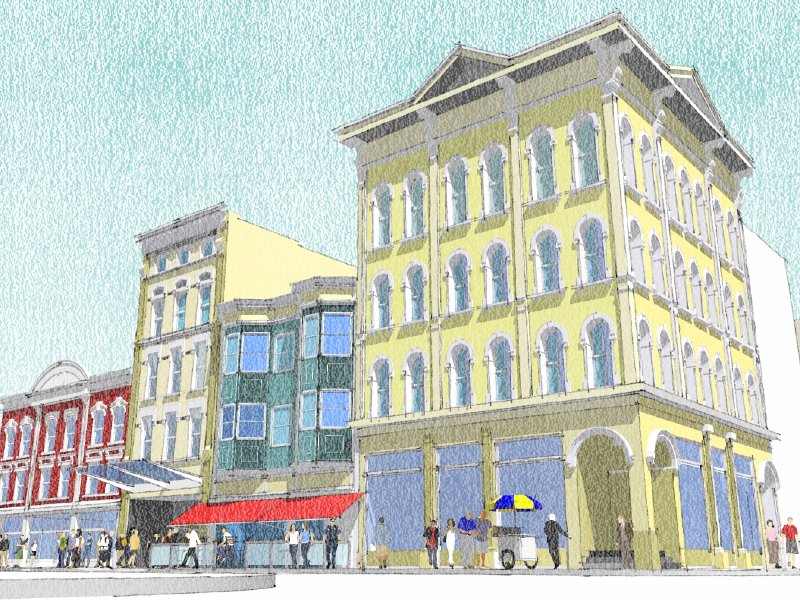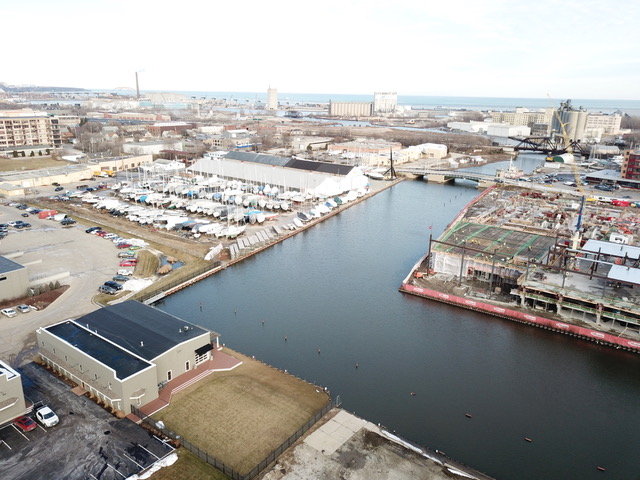John Raettig's my neighbor, a local developer and developer of the the Cawker Building in which I own a condo.
Today, I received an e-mail Raettig sent to Ald. Robert Bauman. It explains his ideas for Sydney HIH. It's posted below so I'll let it do the talking, and you can react to his thought via Facebook and the Talkbacks.
Ald. Bauman,
At the recent Zoning, Neighborhoods and Development committee meeting, I listened toDepartment of City Development and Milwaukee Economic Development Corporation officials present a spirited, but uninspiring discussion about the current economic development challenges at the Park East TIFF.
I am late to the Sydney HIH debate. Lack of bureaucratic transparency contributed to my delay.
Plus, I am a busy guy. But before you vote on whether or not to demolish these buildings, let me offer a private developer's perspective.
I hold a Bachelors & Masters Degree in Architecture from UWM. I have been redeveloping historic, architecturally significant and obsolete properties for my own account and with partners since 1995. For 16 years, I have been a licensed Commercial Real Estate Broker. I live in the 4th Aldermanic District.
A few of my past projects are near City Hall. If you walk down the 700 block of Milwaukee Street, between Wisconsin and Mason, you can experience the result of my work. About 10 years ago, I purchased and repositioned seven blighted properties on that once vacant block.
With a quick walk west down Wells Street, over the river sits the Cawker Building. It was the first Downtown loft condominium conversion project. When I started selling condos there in 1996, the Cawker Building housed more pigeons than Downtown Milwaukee did people. I was laughed at for predicting that the Condominiums would sell out prior to renovations. The pigeons are not laughing now.
The Sydney HIH properties are viable
Some at the City hope to demolish Sydney HIH to make way for bigger and better ... and I fear imaginary ... development. Historic or not, the Sydney HIH properties exist. Their future, whether they are to be renovated or demolished, is best determined by a private owner. Whatever connotations have been attached to the building's past is of little relevance to its future.
Perhaps Milwaukee taxpayers are best served if City Government encourages the redevelopment of all buildings that might be returned to the tax rolls, no matter the perceived condition.
I have learned that an MEDC affiliate paid $769,000 for Sydney HIH in November 2011. But they now contend the buildings are worthless. Milwaukee has many MEDC "development sites" cleared and waiting for action. The property at 4th & Wisconsin and the grass lot at 2nd & Wells come to mind. Each of these empty lots symbolizes a lost group of buildings, and a missed opportunity.
From an economic development perspective, Milwaukee's turn of the century architecture offers more than sentimental journeys. These buildings quietly serve an important role as the incubators and laboratories of small business innovation. They offer price conscience, informal space with inherent architectural character. The freedom to enterprise that fosters limitless job creation often begins in older buildings. Many of Milwaukee's dynamic young companies can attest to that fact. The Sydney HIH can offer the same vital opportunity at Park East to a new generation of downtown entrepreneurs.
Small business drives the economic traffic responsible for solid demographic statistics. Foot traffic, daily car counts, occupancy statistics, and sales figures can be enhanced by including a small business component in the Park East strategy. Large corporations use these statistics to make their site selections. Small business activity can affirm the economic viability of a neighborhood, or create it. Successful small business will attract successful big business. For the Park East, the attraction cycle can launch at Sydney HIH.
Here are the numbers
My financial analysis for each of the four Sydney HIH properties shows that, if saved from demolition and renovated, the four Sydney HIH buildings could together produce annual property tax revenue of $98,957.67 dollars per year. An empty MEDC owned lot ... produces nothing.
My property tax figure does not include other local taxes that a successful private redevelopment would generate. Building permits, parking meters, loading zones, sales tax, stadium tax, convention center district tax, BID district tax, occupancy permits, garbage fees, liquor licenses, sign permits, sidewalk permits, dumpster permits, dance hall licenses, outdoor seating permits, health department permits, personal property taxes on each tenant's fixtures and furniture, annual building inspection fees, sprinkler inspections, façade inspections, etc, and the interests and penalties if one tax is overlooked. This list is off the top of my head. If I've forgotten a tax that is near and dear to your heart, forgive me.
The bottom line – That's a lot of tax revenue! If DCD spends the $435,000 they say it will cost to demolish Sydney HIH, all the annual tax revenue listed above will be lost.
Dissolve the Old Divide
A pedestrian oriented sliver of street level commerce along the Park East's stretch of Third Street will help Milwaukee begin to dissolve the physical and economic separation between Old World Third Street and Dr. Martin Luther King Drive. After all, it is the same street.
A quasi-suburban style corporate campus, hotel, or big box retail development at this location can become a psychological barrier that inhibits new connections with downtown.
Large developments alone without some amount of small scale development will perpetuate the unintended separation of neighborhoods, just like the old highway spur. The Sydney HIH stands ready to begin this process of rebuilding neighborhood connections.
A complimentary approach
While DCD does the important work of recruiting national business to the Park East, let Milwaukee's small businesses start to make important Park East selling points tangible at Sydney HIH. Complimentary economic development activities, a true private / public partnership, will produce the best long term results for the Park East and Milwaukee.
Maybe along the way, Milwaukee's entrepreneurs will plant the seeds of future, home grown corporate headquarters at Park East. After all, Harley Davidson started in a small garage.
Manpower was once a start-up too ... on the ground floor of the Cawker Building.
Your vote to save the Sidney HIH buildings does not signal that you are against new development. On the contrary, your vote to save the Sydney HIH says you support realistic, attainable development. Development that encourages all of Milwaukee's small business community. Development that will help Milwaukee attract large businesses. Development that creates jobs, revives a once vibrant urban fabric, and grows the tax base.
That new vision for vitality at the Park East TIFF can begin today by ending the Raze Order that is set to destroy yet another productive opportunity.
Sincerely,
John Raettig
A life-long and passionate community leader and Milwaukeean, Jeff Sherman is a co-founder of OnMilwaukee.
He grew up in Wauwatosa and graduated from Marquette University, as a Warrior. He holds an MBA from Cardinal Stritch University, and is the founding president of Young Professionals of Milwaukee (YPM)/Fuel Milwaukee.
Early in his career, Sherman was one of youngest members of the Greater Milwaukee Committee, and currently is involved in numerous civic and community groups - including board positions at The Wisconsin Center District, Wisconsin Club and Marcus Center for the Performing Arts. He's honored to have been named to The Business Journal's "30 under 30" and Milwaukee Magazine's "35 under 35" lists.
He owns a condo in Downtown and lives in greater Milwaukee with his wife Stephanie, his son, Jake, and daughter Pierce. He's a political, music, sports and news junkie and thinks, for what it's worth, that all new movies should be released in theaters, on demand, online and on DVD simultaneously.
He also thinks you should read OnMilwaukee each and every day.







